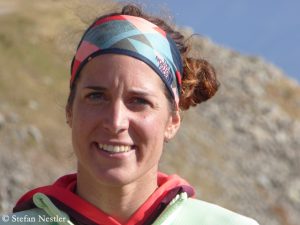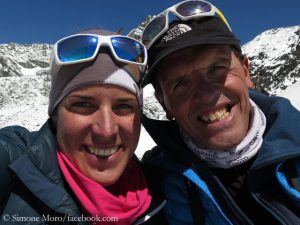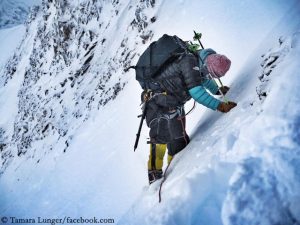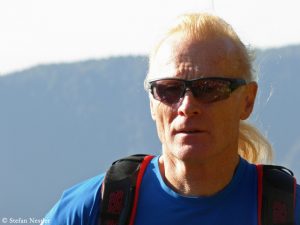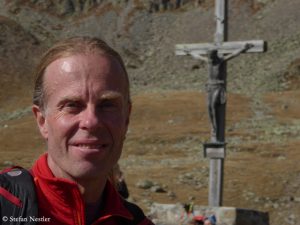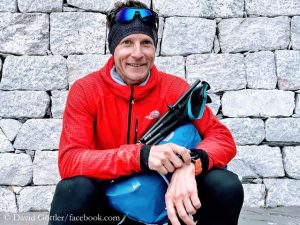Tamara Lunger: “I am currently searching”
“I often wish I had been born a hundred years ago,” says Tamara Lunger. “When I hear the 90-year-olds talking, I think to myself: Oh, they were still adventurers! Today we are only pussies compared to them.” Yet, in 2010, at the age of 23, the professional climber from South Tyrol stood on the summit of the eight-thousander Lhotse, as the youngest woman at that time, and in 2014, she scaled K2, the second highest mountain on earth, without bottled oxygen.
During the “International Mountain Summit” in Brixen I am hiking with Tamara from the Latzfonserkreuz downhill. Her parents are keeping the alpine hut up there. We talk about Tamara’s adventures of the past years. The 32-year-old is a honest soul and doesn’t mince her words: “People tell me: ‘You can talk easily, you can live what gives you pleasure.’ However, sometimes there is something negative in my pleasure that I have to accept and learn from. That’s actually what’s important.”
Close to death
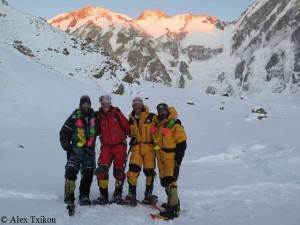
Tamara (2nd from l.) with the winter first ascenders of Nanga Parbat, Alex Txikon, Simone Moro and Muhammad Ali “Sadpara” (from l.)
In February 2016 in Pakistan, Tamara Lunger turned around just below the summit of Nanga Parbat. She was only 70 meters short of fame to become the first woman among those who succeeded winter first ascents of an eight-thousander. During the whole summit day she had felt bad, she quasi had dragged herself up the mountain. Then God spoke to her, Tamara tells me: “Normally I always get what I ask for. But that day, ten hours of praying did not help. Then I knew there was something wrong.” She turned around. In the descent she slipped. “It was my experience closest to death so far. I also talked to the Lord when I fell: ‘I didn’t think it would happen so early now. But if that’s the way it has to be, I’m ready, and that’s okay.'” After 200 meters Tamara stopped slipping in loose snow.
Much learned
She survived with injuries of her shoulder and ankle. In the following weeks she was in pain, not allowed to do any sports. And the media hassled her with interview requests. It was a “difficult time”, says the climber. “It was only with time that I understood what Nanga Parbat had given me.” Now she knows that it doesn’t always have to be the summit, says Tamara. “I also learned a lot about myself. For example, how I behave in fear of death. Do I panic or remain calm? Can I still think clearly? These insights are extremely important because they are part of the game in our profession or vocation.”
Lack of respect
Her next eight-thousander expedition in spring 2017 led her to Kangchenjunga, the third highest mountain in the world. With her team partner and mentor Simone Moro, she wanted to traverse all peaks of the massif. However, this did not happen because Moro’s health did not play along. The experiences in the base camp, which the two professional climbers shared with members of commercial expeditions, spoiled climbing eight-thousanders for Lunger for the moment. “It’s incredible what some people are doing there,” says Tamara and shakes her head. “I was partly ashamed of them. The only thing they wanted was to get up somehow. They no longer have any respect, neither for the mountain, nor for other people. In the high camps people are stealing.”
Never again a base camp with others
A Sherpa of the Nepalese operator “Seven Summit Treks” had felt pretty bad on the mountain, unable to descent. “The boss of the Sherpas didn’t give a damn. He preferred to play around with his mobile phone on Facebook instead of helping.” That was so much against her principles that she was losing all her strength, says Tamara: “I swore to myself at the time: No more going to a base camp with other people! I hope I can pull it. In the future, I will approach the mountains in winter or from another side, with a base camp where I have my peace.
Relief in the cold of Eastern Siberia
Last February, Lunger and Moro succeeded the first winter ascent of the 3,003-meter-high Gora Pobeda (also known as Pik Pobeda) in the ice-cold Eastern Siberia at temperatures of minus 50 degrees Celsius. After the failure on Manaslu in winter 2015, her turnround on Nanga Parbat in winter 2016 and her unsuccessful attempt on Kangchenjunga in 2017, she felt under great pressure, Tamara says. She tried to enjoy every step in the beautiful nature of Siberia and not to think about what any people expected of her. “I did that relatively well and it really set me free. When I arrived at the summit, I breathed a sigh of relief. At last!”
Living what she feels
In her future adventures she wants to listen more to her inner voice, Tamara Lunger reveals: “I try to live what I feel. I can’t tell what I’ll do tomorrow or in a week from now. I am currently searching.” And she is not only fixated on the mountains. “I would also like to set off with a sailboat.”



